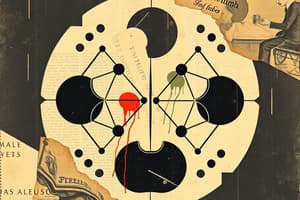Podcast
Questions and Answers
What does growth depend on?
What does growth depend on?
Cells must first make a complete copy of their DNA before cell division
What are chromosomes?
What are chromosomes?
Chromosomes are condensed, organized structures of DNA that become visible during cell division.
Describe prokaryotic cells and their DNA.
Describe prokaryotic cells and their DNA.
Prokaryotic cells have a single, circular DNA molecule called a nucleoid that is not enclosed within a membrane-bound nucleus.
Eukaryotic chromosomes contain DNA tightly bound to proteins called ______.
Eukaryotic chromosomes contain DNA tightly bound to proteins called ______.
DNA + histones = [blank]
DNA + histones = [blank]
What is chromatin?
What is chromatin?
When does chromatin condense into chromosomes?
When does chromatin condense into chromosomes?
Why do we have chromosomes?
Why do we have chromosomes?
What happens during the cell cycle?
What happens during the cell cycle?
Describe the prokaryotic cell cycle.
Describe the prokaryotic cell cycle.
What are the 4 stages of the eukaryotic cell cycle?
What are the 4 stages of the eukaryotic cell cycle?
What does interphase consist of?
What does interphase consist of?
What does the “M phase” represent?
What does the “M phase” represent?
What happens during G1?
What happens during G1?
What are the two stages of the M phase (cell division)?
What are the two stages of the M phase (cell division)?
What is mitosis?
What is mitosis?
What is cytokinesis?
What is cytokinesis?
What are the four phases of mitosis?
What are the four phases of mitosis?
Describe what happens during prophase. Include a picture.
Describe what happens during prophase. Include a picture.
What are centrioles?
What are centrioles?
What are sister chromatids?
What are sister chromatids?
Describe what happens during cytokinesis. Include a picture.
Describe what happens during cytokinesis. Include a picture.
Explain cytokinesis in animal cells.
Explain cytokinesis in animal cells.
Explain cytokinesis in plant cells.
Explain cytokinesis in plant cells.
Sister chromatids are attached to each other at an area called the
Sister chromatids are attached to each other at an area called the
If a cell has 12 chromosomes, how many chromosomes will each of its daughter cells have after mitosis and cytokinesis?
If a cell has 12 chromosomes, how many chromosomes will each of its daughter cells have after mitosis and cytokinesis?
In plant cells, what forms midway between the divided nuclei during cytokinesis?
In plant cells, what forms midway between the divided nuclei during cytokinesis?
Flashcards
Role of chromosomes in cell division
Role of chromosomes in cell division
Chromosomes carry genetic information (DNA) and must be duplicated before cell division to ensure each daughter cell receives a complete set.
Cell Cycle Stages
Cell Cycle Stages
The ordered sequence of events in a cell's life from one division to the next, including interphase (G1, S, G2) and the mitotic phase (mitosis and cytokinesis).
Mitosis Phases
Mitosis Phases
The division of the nucleus into two genetically identical nuclei. Four main stages: prophase, metaphase, anaphase, and telophase.
Daughter cell separation after Meiosis
Daughter cell separation after Meiosis
Signup and view all the flashcards
Chromosomes
Chromosomes
Signup and view all the flashcards
Prokaryotic DNA
Prokaryotic DNA
Signup and view all the flashcards
Eukaryotic DNA
Eukaryotic DNA
Signup and view all the flashcards
Histones
Histones
Signup and view all the flashcards
Chromatin
Chromatin
Signup and view all the flashcards
Chromosomes vs. chromatin
Chromosomes vs. chromatin
Signup and view all the flashcards
Chromatid
Chromatid
Signup and view all the flashcards
Interphase
Interphase
Signup and view all the flashcards
G1 phase
G1 phase
Signup and view all the flashcards
S phase
S phase
Signup and view all the flashcards
G2 phase
G2 phase
Signup and view all the flashcards
M phase
M phase
Signup and view all the flashcards
Mitosis
Mitosis
Signup and view all the flashcards
Cytokinesis
Cytokinesis
Signup and view all the flashcards
Prophase
Prophase
Signup and view all the flashcards
Metaphase
Metaphase
Signup and view all the flashcards
Anaphase
Anaphase
Signup and view all the flashcards
Telophase
Telophase
Signup and view all the flashcards
Cytokinesis in animal cells
Cytokinesis in animal cells
Signup and view all the flashcards
Cytokinesis in plant cells
Cytokinesis in plant cells
Signup and view all the flashcards
Centrioles
Centrioles
Signup and view all the flashcards
Centromere
Centromere
Signup and view all the flashcards
Study Notes
Cell Division and Chromosomes
- Cell growth depends on copying genetic material.
- Cells must duplicate their DNA before division.
- Chromosomes are structures containing DNA tightly bound to proteins (histones).
What is chromatin?
- Chromatin is the less condensed form of DNA found during interphase.
Cell Cycle
- The cell cycle describes the stages cells go through as they grow and divide.
- The eukaryotic cell cycle consists of interphase and the mitotic (M) phase.
- Interphase is divided into G1, S, and G2 phases.
- G1: Cell growth
- S: DNA replication
- G2: Cell growth and preparation for division
- M Phase (cell division): mitosis and cytokinesis.
Mitosis
- Mitosis is a cell division process that results in two genetically identical daughter cells.
- It includes four stages: prophase, metaphase, anaphase, and telophase.
Cytokinesis
- Cytokinesis is the division of the cytoplasm.
- It differs in animal and plant cells. Animal cells pinch inward, plant cells form a cell plate.
Prokaryotic vs. Eukaryotic DNA
- Prokaryotic: DNA is not bound to proteins and exists as a circular loop.
- Eukaryotic: DNA is bound to proteins (histones) and organized into multiple linear chromosomes.
Sample Questions
- Sister chromatids connect at centromeres.
- If a cell has 12 chromosomes, each daughter cell will have 12 after mitosis and cytokinesis.
- A cell plate forms in plant cells during cytokinesis.
Studying That Suits You
Use AI to generate personalized quizzes and flashcards to suit your learning preferences.




